Biological and Hydrodynamic Aspects for the Design of Artificial Reef Modules for Cephalopod Molluscs in the Ares-Betanzos Estuary
Abstract
:1. Introduction
1.1. The Problem of Cephalopods in Galicia: Evolution of Artisanal Fishing
1.2. Natural Breeding Habitats for Cephalopods
1.3. Objectives and Key Innovative Aspects
- Defining suitable AR geometries to improve primary production by increasing autotrophic sources of substrate and nutrient circulation so that these reefs can function as a refuge and provide space for recruitment with available nest cavities.
- Performing a CFD analysis of the water flows (upwelling) generated in both the nest cavities and the vertical surfaces of the previously defined designs.
- Establishing a new tool for assessing the extent to which each design favours nutrient circulation: the Nest Cavity Circulation (NCC) index. The NCC is partially based on the results obtained in the CFD analysis.
- Comparing the AR designs by applying two indicators: the NCC index and the existing AREIT (AR Ecosystem Index Transformation) tool.
2. Materials and Methods
2.1. Proposed Artificial Reef Designs for the Embryonic Development of Cephalopod Molluscs in Galicia
2.2. Computational Fluid Dynamics (CFD) Analysis
- -
- Orientation A: 250 mm diameter hole parallel to the current velocity.
- -
- Orientation B: 450 mm diameter hole parallel to the current velocity.
- -
- Upwelling volume (Vupwelling): volume of the vortex formed above the AR where the x-component of the velocity is negative.
- -
- Back eddy volume (Vbackeddy): volume of the vortex formed behind the AR where the x-component of the velocity is negative.
- -
- Average flow velocity inside the AR (va): average flow velocity considering only the volume inside the AR.
2.3. AREIT and NCC Indices
3. Results and Discussion
3.1. AREIT Index Results
3.2. CFD Results
3.3. NCC Index Results
4. Conclusions
Author Contributions
Funding
Institutional Review Board Statement
Informed Consent Statement
Data Availability Statement
Acknowledgments
Conflicts of Interest
References
- Worm, B.; Barbier, E.B.; Beaumont, N.; Duffy, J.E.; Folke, C.; Halpern, B.S.; Jackson, J.B.C.; Lotze, H.K.; Micheli, F. Impacts of biodiversity loss on ocean ecosystem services. Science 2006, 314, 787–790. [Google Scholar] [CrossRef] [Green Version]
- Boyle, P.R.; Rodhouse, P. Cephalopods: Ecology and Fisheries; Blackwell Pub: Calgary, AB, USA, 2005. [Google Scholar]
- Guerra, A.; Hernández-Urcera, J.; Garci, M.E.; Sestelo, M.; Regueira, M.; Gilcoto, M.; González, A.F. Spawning habitat selection by the common cuttlefish Sepia officinalis in the Cíes Islands (Northwest Spain). Fish. Res. 2016, 183, 44–54. [Google Scholar] [CrossRef] [Green Version]
- Arkhipkin, A.I.; Rodhouse, P.G.K.; Pierce, G.J.; Sauer, W.; Sakai, M.; Allcock, L. World squid fisheries. Rev. Fish. Sci. Aquac. 2015, 23, 92–252. [Google Scholar] [CrossRef] [Green Version]
- Carral, L.; Alvarez-Feal, J.C.; Tarrio-Saavedra, J.; Rodriguez Guerreiro, M.J.; Fraguela, J.A. Social interest in developing a green modular artificial reef structure in concrete for the ecosystems of the Galician rías. J. Clean. Prod. 2018, 172, 1881–1898. [Google Scholar] [CrossRef]
- Hutchings, J.A. Collapse and recovery of marine fishes. Nature 2000, 406, 882–885. [Google Scholar] [CrossRef]
- Carral, L.; Jesús Rodríguez, M.; Fraguela, J.Á.; Díaz, V.; Álvarez, J.C.; Ferreño, S. Módulo para Formación de Arrecifes Artificiales. ES2579027, 31 January 2017. Available online: https://patentados.com/2016/modulo-para-la-formacion-de-arrecifes.1 (accessed on 27 May 2023).
- Carral, L.; Alvarez-Feal, C.; Rodríguez-Guerreiro, M.J.; Vargas, A.; Arean, N.; Carballo, R. Methodology for positioning a group of green artificial reef based on a database management system, applied in the estuary of Ares-Betanzos (Nw Iberian Peninsula). J. Clean. Prod. 2019, 233, 1047–1060. [Google Scholar] [CrossRef]
- Becker, A.; Taylor, M.; Folpp, H.; Lowry, M. Revisiting an artificial reef after 10 years: What has changed and what remains the same? Fish. Res. 2022, 249, 106261. [Google Scholar] [CrossRef]
- Herrera Pérez, R.B. Dinámica de las Comunidades Bentónicas de los Arrecifes Artificiales de Arguineguín (Gran Canaria) y Lanzarote. Ph.D. Thesis, Facultad de Ciencias del Mar, Puerto Real, Spain, 1998. [Google Scholar]
- Seaman, W.; Sprague, L.M. Artificial Habitats for Marine and Freshwater Fisheries; Academic Press: Cambridge, MA, USA, 1991. [Google Scholar]
- Carral, L.; Lamas, M.I.; Cartelle Barros, J.J.; López, I.; Carballo, R. Proposed conceptual framework to design artificial reefs based on particular ecosystem ecology traits. Biology 2022, 11, 680. [Google Scholar] [CrossRef]
- Allemand, W.J.; Debernardi, D. Artificial reefs in the Principality of Monaco: Protection and enhancement of coastal zones. In Artificial Reefs in European Seas; Kluver Academic Publishers: Dordrecht, The Netherlands, 2000; pp. 151–166. [Google Scholar]
- Barnabé, G.; Charbonnel, E.; Marinaro, J.Y.; Ody, D.; Francour, P. Artificial reefs in France: Analysis, assessments and prospects. In Artificial Reefs in European Seas; Jensen, A.C., Collins, K.J., Lockwood, A.P.M., Eds.; Springer: Dordrecht, The Netherlands, 2000; pp. 167–184. [Google Scholar]
- Costa Monteiro, C.; Neves Santos, M. Portuguese artificial reefs. In Artificial Reefs in European Seas; Kluver Academic Publishers: Dordrecht, The Netherlands, 2000; pp. 249–261. [Google Scholar]
- Guerra, A.; Garci, M.E.; Hernández-Uicera, J.; González, A. Hábitats para la Puesta de Cefalópodos en el Parque Nacional Marítimo Terrestre de las Islas Atlánticas de Galicia; Sociedad de Ciencias de Galicia: Pontevedra, Spain, 2013. [Google Scholar]
- Carral, L.; Camba Fabal, C.; Lamas Galdo, M.I.; Rodríguez-Guerreiro, M.J.; Cartelle Barros, J.J. Assessment of the materials employed in green artificial reefs for the Galician estuaries in terms of circular economy. Int. J. Environ. Res. Public Health 2020, 17, 8850. [Google Scholar] [CrossRef]
- Camba, C.; Mier, J.L.; Carral, L.; Lamas, M.I.; Álvarez, J.C.; Díaz-Díaz, A.M.; Tarrío-Saavedra, J. Erosive degradation study of concrete augmented by mussel shells for marine construction. J. Mar. Sci. Eng. 2021, 9, 1087. [Google Scholar] [CrossRef]
- Carral, L.; Lamas Galdo, M.I.; Buenhombre, J.L.M.; Barros, J.J.C.; Naya, S.; Tarrio-Saavedra, J. Application of the residuals from purification of bivalve molluscs in Galician to facilitate marine ecosystem resiliency through artificial reefs with shells—One generation. Sci. Total Environm. 2023, 856, 159095. [Google Scholar] [CrossRef] [PubMed]
- Guerra, A. Mollusca, Cephalopoda. In Fauna Ibérica; Museo Nacional de Ciencias Naturales (CSIC): Madrid, Spain, 1992; Volume 1. [Google Scholar]
- Consellería do Mar da Xunta de Galicia. Official statistics for the Galician Fishing Activity; Pesca de Galicia: Galicia, Spain, 2021. [Google Scholar]
- Villasante, S. Sostenibilidad de las Pesquerías Artesanales de Galicia; Netbiblo: A Coruña, Spain, 2010. [Google Scholar]
- Guerra, M.E.; Hernández-Urcera, A.; Garcí, J.; Cabanellas-Reboredo, B.; Sestelo, M.; Palmer, M.; Regueira, M.; Gilcoto, M.; Calvo-Manazza, M.; González, M.; et al. Identificación y caracterización de hábitats esenciales para tres especies de cefalópodos en los parques nacionales de las islas Atlánticas de Galicia y Cabrera. In Proyectos de Investigación en Parques Nacionales: 2012–2015; Serie Investigación en la, Red; Armengol, J., Ed.; Organismo Autónomo de Parques Nacionales, MAPAMA, Naturaleza y Parques Nacionales: Madrid, Spain, 2018; pp. 13–43. [Google Scholar]
- Avendaño, O.; Velazquez-Abunader, I.; Fernández-Jardón, C.; Ángeles-González, L.E.; Hernández-Flores, A.; Guerra, A. Biomass and distribution of the red octopus (Octopus maya) in the north-east of the Campeche Bank. J. Mar. Biol. Assoc. UK 2019, 99, 1317–1323. [Google Scholar] [CrossRef] [Green Version]
- Pierce, G.J.; Valavanis, V.D.; Guerra, A.; Jereb, P.; Orsi-Relini, L.; Bellido, J.M.; Katara, I.; Piatkowski, U.; Pereira, J.; Balguerias, E.; et al. A review of cephalopod–environment interactions in European seas. Hydrobiologia 2008, 612, 49–70. [Google Scholar] [CrossRef]
- Ramos, J.E.; Pecl, G.T.; Moltschaniwskyj, N.A.; Strugnell, J.M.; León, R.I.; Semmens, J.M. Body size, growth and life span: Implications for the polewards range shift of Octopus tetricus in South-Eastern Australia. PLoS ONE 2014, 9, e103480. [Google Scholar] [CrossRef]
- Garci, M.E.; Hernández-Urcera, J.; Gilcoto, M.; Fernández-Gago, R.; González, A.F.; Guerra, A. From brooding to hatching: New insights from a female Octopus vulgaris in the wild. J. Mar. Biol. Assoc. UK 2015, 96, 1341–1346. [Google Scholar] [CrossRef]
- Hartwick, B.; Ambrose, R.F.; Robinson, S.M.C. Dynamic of shallow-water population of Octopus dofeini. Mar. Biol. 1984, 82, 65–72. [Google Scholar] [CrossRef]
- Katsanevakis, G.; Verriopoulos, S. Den ecology of Octopus vulgaris Cuvier, 1797, on soft sediment: Availability and types of shelter. Sci. Mar. 2004, 68, 147–157. [Google Scholar] [CrossRef] [Green Version]
- Mather, J.A. Factors affecting the spatial distribution of natural populations of Octopus joubini robson. Anim. Behav. 1982, 30, 1166–1170. [Google Scholar] [CrossRef]
- Mereu, D.; Agus, M.; Cannas, B.; Cau, R.; Coluccia, A.; Cuccu, E. Mark-recapture investigation on Octopus vulgaris specimens in an area of the central western Mediterranean Sea. J. Mar. Biol. Assoc. UK 2015, 95, 131–138. [Google Scholar] [CrossRef]
- Hanlon, R.T.; Messenger, J.B. Cephalopod Behaviour; Cambridge University Press: Cambridge, UK, 1996. [Google Scholar]
- Leite, T.S.; Haimovici, M.; Mather, J.; Oliveira, J.E.L. Habitat, distribution, and abundance of the commercial octopus (Octopus insularis) in a tropical oceanic island, Brazil: Information for management of an artisanal fishery inside a marine protected area. Fish. Res. 2009, 98, 85–91. [Google Scholar] [CrossRef]
- Guerra, A.; Hernández-Urcera, J.; Garci, M.E.; Sestelo, M.; González, A.F.; Cabanellas-Reboredo, M.; Calvo-Manazza, M.; Morales-Nin, B. Dwellers in dens on sandy bottoms: Ecological and behavioural traits of Octopus vulgaris. Sci. Mar. 2014, 78, 405–414. [Google Scholar] [CrossRef] [Green Version]
- Mather, J.A. Home choice and modifications by juvenile Octopus vulgaris (Mollusca: Cephalopoda): Specialized intelligence and tool use? J. Zool. 1994, 233, 359–368. [Google Scholar] [CrossRef]
- Alonso-Fernández, G.; Otero, A.; Bañón, J.; Campelos, R.; Santos, J.M.; Mucientes, J. Sex ratio variation in an exploited population of common octopus: Ontogenic shifts and spatio-temporal dynamics. Hydrobiologia 2017, 794, 1–16. [Google Scholar] [CrossRef] [Green Version]
- Boal, J.G. Behavioral research methods for octopuses and cuttlefishes. Vie Milieu 2011, 61, 203–210. [Google Scholar]
- García-Martínez, M.; Moya, M.C.; González, F.; Torres, M.; Farzaneh, P.; Vargas-Yañez, S. Comparative pattern of Octopus vulgaris life cycle with environmental parameters in the Northern Alboran Sea (Western Mediterranean Sea). Turk. J. Fish. Aquat. Sci. 2018, 18, 247–257. [Google Scholar] [CrossRef] [PubMed]
- Rocha, F.; Guerra, A.; González, A.F. A review of reproductive strategies in cephalopods. Biol. Rev. 2001, 76, 291–304. [Google Scholar] [CrossRef] [PubMed]
- Hernández-Urcera, J.; Garci, M.E.; Roura, A.; González, A.F.; Cabanellas-Reboredo, M.; Morales-Nin, B.; Guerra, A. Cannibalistic behavior of octopus (Octopus vulgaris) in the wild. J. Comp. Psychol. 2014, 128, 427–430. [Google Scholar] [CrossRef] [Green Version]
- Mangold, K.; Boletzky, S. New data on reproductive biology and growth of Octopus vulgaris. Mar. Biol. 1973, 19, 7–12. [Google Scholar] [CrossRef]
- Villanueva, R.; Norman, M.D. Biology of the Planktonic Stages of Benthic Octopuses; Taylor & Francis: Abingdon, UK, 2008. [Google Scholar]
- Chung, W.S. Effects of Temperature, Salinity and Photoperiod on the Deposition of Growth Increments in Statoliths of the Oval Squid Sepioteuthis Lessoniana Lesson, 1830 (Cephalopoda: Loliginidae) during Early Stages; National Sun Yatsen University: Kaohsiung City, Taiwan, 2003. [Google Scholar]
- Strathmann, R.R.; Strathmann, M.F. Oxygen supply and limits on aggregation of embryos. J. Mar. Biol. Assoc. UK 1995, 75, 413–428. [Google Scholar] [CrossRef]
- Bloor, I.S.M.; Attrill, M.J.; Jackson, E.L. A review of the factors influencing spawning, early life stage survival and recruitment variability in the common cuttlefish (Sepia officinalis). In Advances in Marine Biology; Academic Press: Cambridge, MA, USA, 2013; Volume 65, pp. 1–65. [Google Scholar]
- Lishchenko, F.; Perales-Raya, C.; Barrett, C.; Oesterwind, D.; Power, A.M.; Larivain, A.; Laptikhovsky, V.; Karatza, A.; Badouvas, N.; Lishchenko, A.; et al. A review of recent studies on the life history and ecology of European cephalopods with emphasis on species with the greatest commercial fishery and culture potential. Fish. Res. 2020, 236, 105847. [Google Scholar] [CrossRef]
- Carral, L.; Cartelle Barros, J.J.; Carro Fidalgo, H.; Camba Fabal, C.; Munín Doce, A. Greenhouse gas emissions and energy consumption of coastal ecosystem enhancement programme through sustainable artificial reefs in Galicia. Int. J. Environ. Res. Public Health 2021, 18, 1909. [Google Scholar] [CrossRef] [PubMed]
- Carral, L.; Tarrío-Saavedra, J.; Cartelle, J.J.; Camba-Fabal, C.; Ramil, A.; Álvarez-Feal, C. Design of artificial reef with a functional life limited to one generation. Heliyon 2023. [Google Scholar] [CrossRef]
- Bohnsack, J.A.; Sutherland, D.L. Artificial reef research: A review with recommendations for future priorities. Bull. Mar. Sci. 1985, 37, 11–39. [Google Scholar]
- Higo, S.; Tabata, N. On the fish gathering effect of the artificial reefs ascertained by diving observation. IV. At the sea in the west of Biro Island in the Shibushi Bay. Mem. Fac. Fish. Kagoshima Univ. 1979, 28, 107–117. [Google Scholar]
- Higo, N.; Tabata, S.; Nagashima, M.; Sakono, S. On the fish gathering effect of the artificial reefs ascertained by diving observation. VII At the off sea of Maskura City. Mem. Fac. Fish. Kagoshima Univ. 1980, 29, 51–63. [Google Scholar]
- Higo, N.; Higo, N.M. On the fish gathering effect of the artificial reefs ascertained by diving observation II. At the sea of the Satsuma Peninsula in Kagoshima Prefecture. Mem. Fac. Fish. Kagoshima Univ. 1978, 27, 117–130. [Google Scholar]
- Lemoine, H.R.; Paxton, A.B.; Anisfeld, S.C.; Rosemond, R.C.; Peterson, C.H. Selecting the optimal artificial reefs to achieve fish habitat enhancement goals. Biol. Conserv. 2019, 238, 108200. [Google Scholar] [CrossRef]
- Ogawa, Y.; Takemura, Y. Experiments on the attractiveness of artificial reefs for marine fishes III. Observations on stone bream in the outdoor tank. Bull. Tokai Reg. Fish. Res. Lab. 1966, 46, 127–135. [Google Scholar]
- Walton, J.M. Puget sound artificial reef study. State of Washington. Dep. Fish. Tech. Rep. 1979, 50, 130. [Google Scholar]
- Chang, K.H.; Lee, S.C.; Kwang-Tsao, S. Evaluation of artificial reef efficiency based on the studies of model reef fish community installed in northern Taiwan. Bull. Inst. Zool. Acad. Sin. 1977, 16, 23–36. [Google Scholar]
- Mottet, M.G. Enhancement of the marine environment for fisheries and aquaculture in Japan. Washingt. Dep. Fish. Tech. Rep. 1981, 69, 96. [Google Scholar]
- Ogawa, Y. The present status and future prospects of artificial reefs: Developmental trends of artificial reef units. In Japanese Artificial Reef Technology; Vik, S.F., Ed.; Aquabio Inc.: Belleair Bluffs, FL, USA, 1982; pp. 23–41. [Google Scholar]
- Grove, R.S.; Sonu, C.J. Review of Japanese Fishing Reef Technology; Technical Report 83-RD-137; Southern California Edison Company: Rosemead, CA, USA, 1983. [Google Scholar]
- White, A.T.; Ming, C.L.; de Silva, M.W.R.N.; Guarin, F.Y. Artificial reefs for marine habitat enhancement in Southeast Asia; Association of Southeast Asian Nations: Manila, Philippines, 1990; ISBN 971-1022-83-4. [Google Scholar]
- Bombace, G.; Fabi, G.; Fiorentini, L. Artificial Reefs in the Adriatic Sea. In Artificial Reefs in European Seas; Springer: Dordrecht, The Netherlands, 2000; pp. 31–63. [Google Scholar]
- Badalamenti, F.; D’Anna, G.; Riggio, S. Artificial reefs in the Gulf of Castellammare (North-West Sicily): A case study. In Artificial Reefs in European Seas; Springer: Dordrecht, The Netherlands, 2000; pp. 75–96. [Google Scholar]
- Relini, G. The Loano artificial reef. In Artificial Reefs in European Seas; Springer: Dordrecht, The Netherlands, 2000; pp. 129–149. [Google Scholar]
- Carral, L.; Lamas-Galdo, M.I.; Rodríguez-Guerreiro, M.J.; Vargas, A.; Álvarez-Fea, C.; López, I.; Carballo, R. Configuration methodology for a green variety reef system (AR group) based on hydrodynamic criteria—Application to the Ría de Ares-Betanzos. Estuar. Coast. Shelf Sci. 2021, 252, 107301. [Google Scholar] [CrossRef]
- Lamas Galdo, M.I.; Rodríguez Guerreiro, M.J.; Lamas Vigo, J.; Ameneiros Rodriguez, I.; Veira Lorenzo, R.; Carral Couce, J.C.; Carral Couce, L. Definition of an artificial reef unit through hydrodynamic and structural (CFD and FEM) models—Application to the Ares-Betanzos estuary. J. Mar. Sci. Eng. 2022, 10, 230. [Google Scholar] [CrossRef]
- Santiago Caamaño, L.; Lamas Galdo, M.I.; Carballo, R.; López, I.; Cartelle Barros, J.J.; Carral, L. Numerical and experimental analysis of the velocity field inside an artificial reef. Application to the Ares-Betanzos estuary. J. Mar. Sci. Eng. 2022, 10, 1827. [Google Scholar] [CrossRef]
- Zhou, P.; Gao, P.; Zheng, S. Three-dimensional numerical simulation on flow behavior behind trapezoidal artificial reefs. Ocean Eng. 2022, 266, 112899. [Google Scholar] [CrossRef]


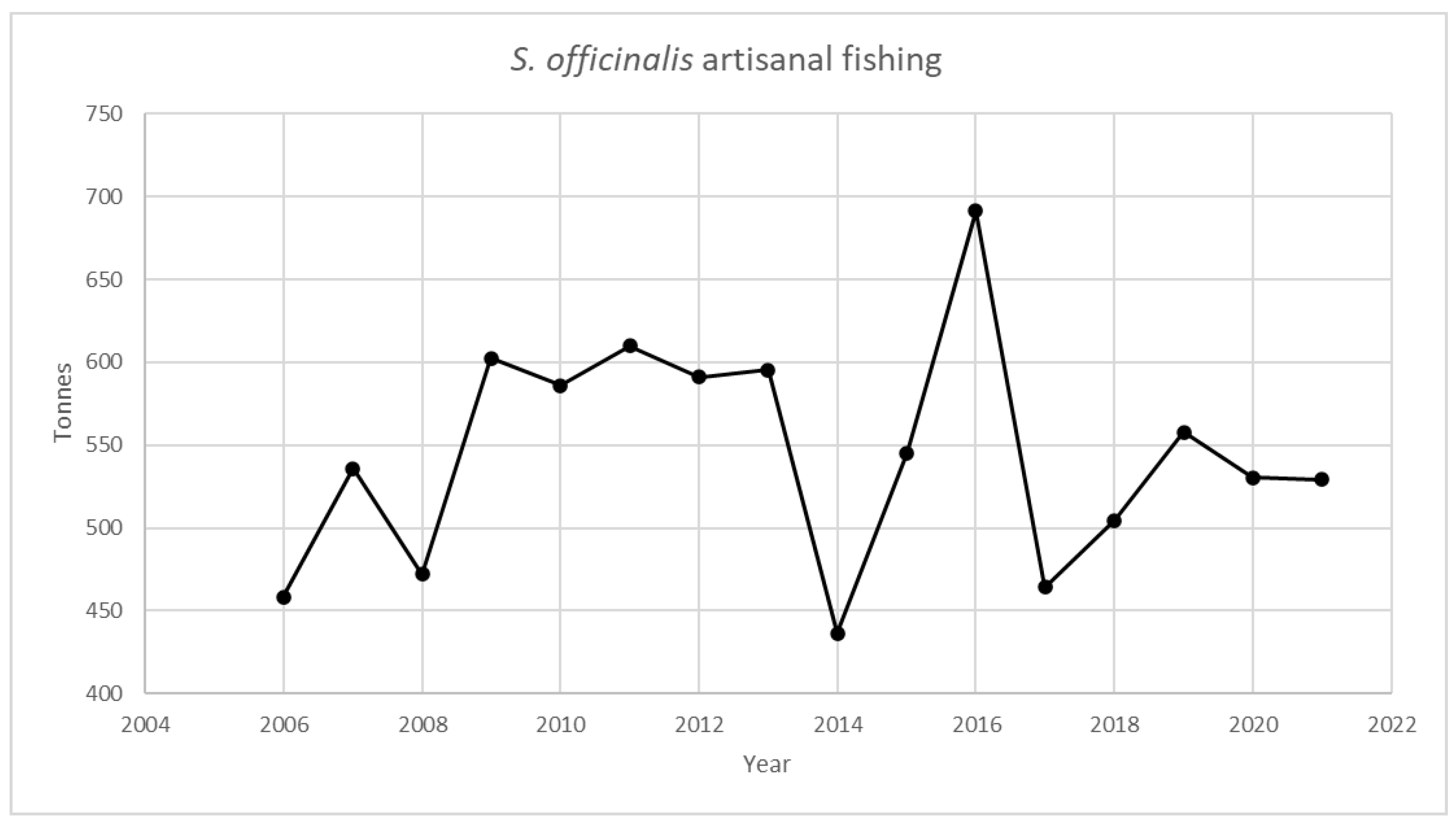
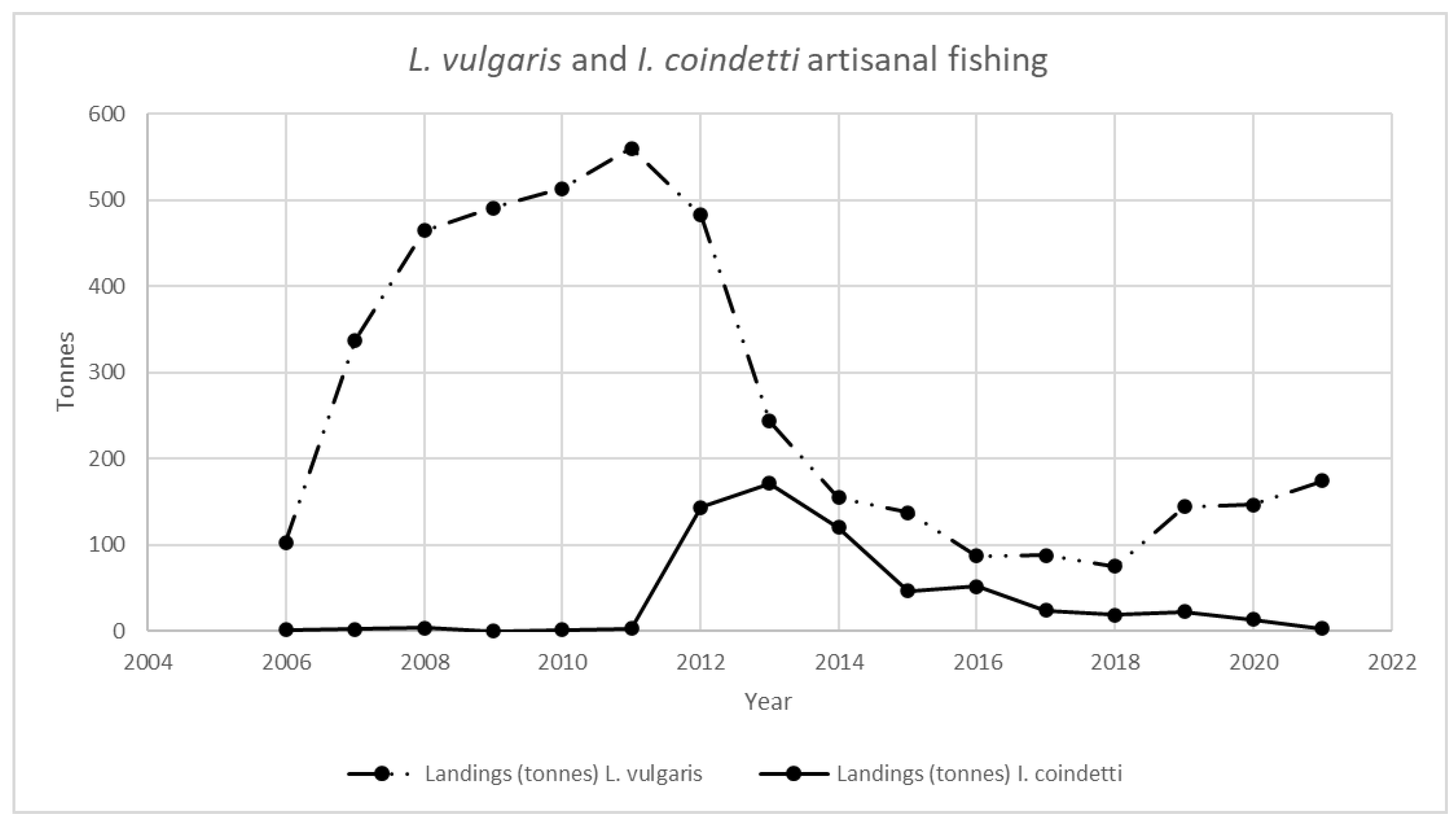
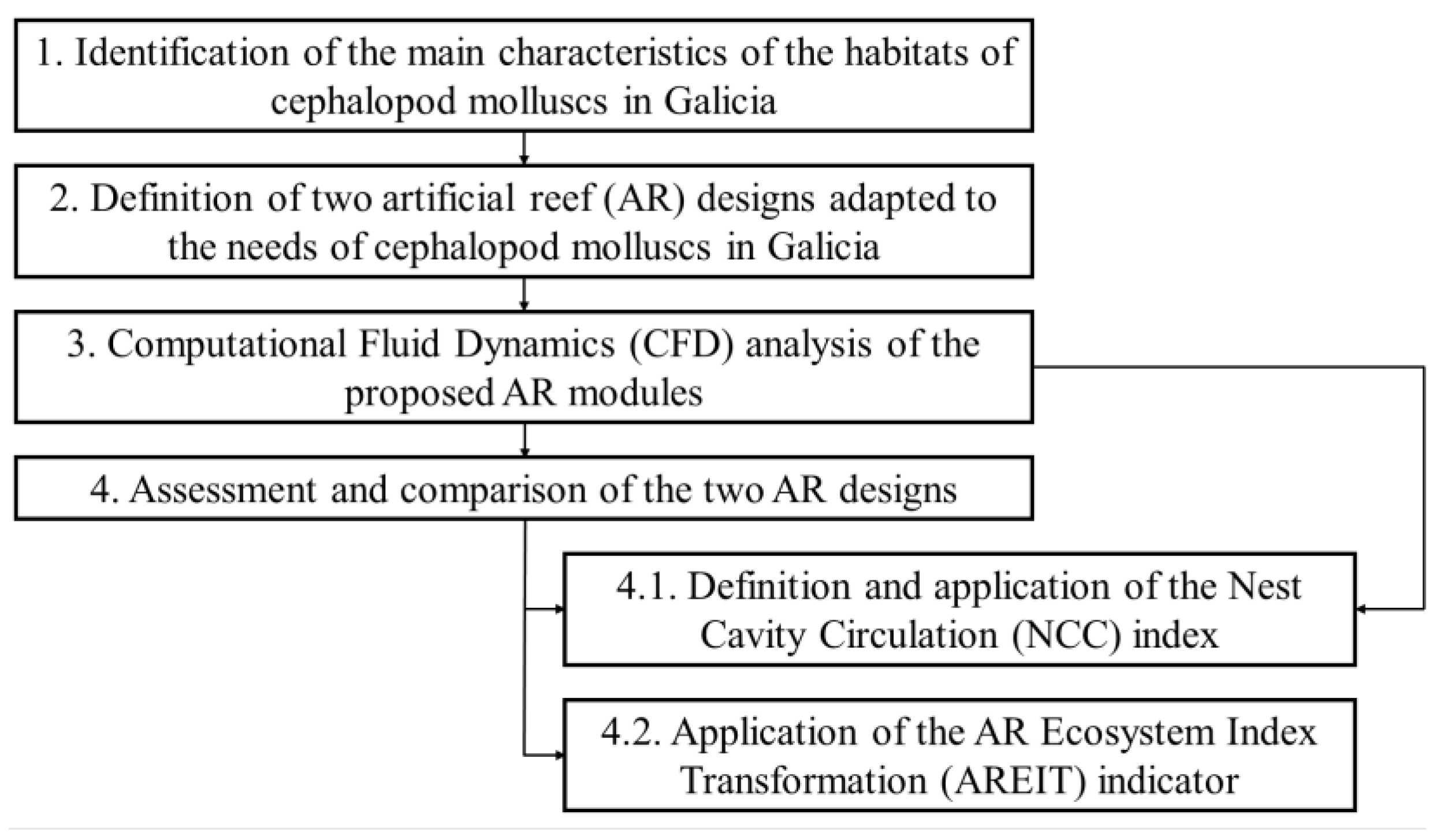

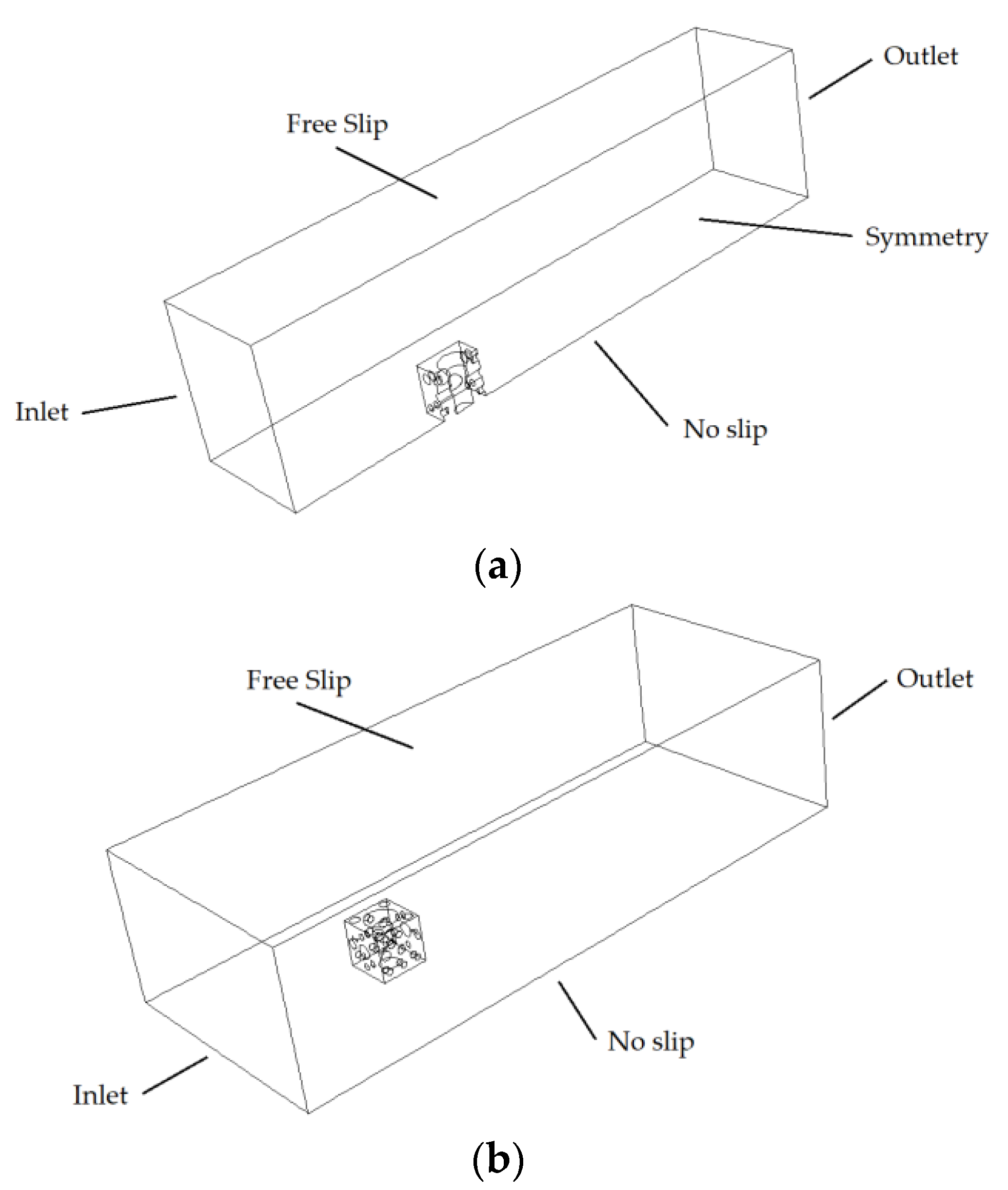
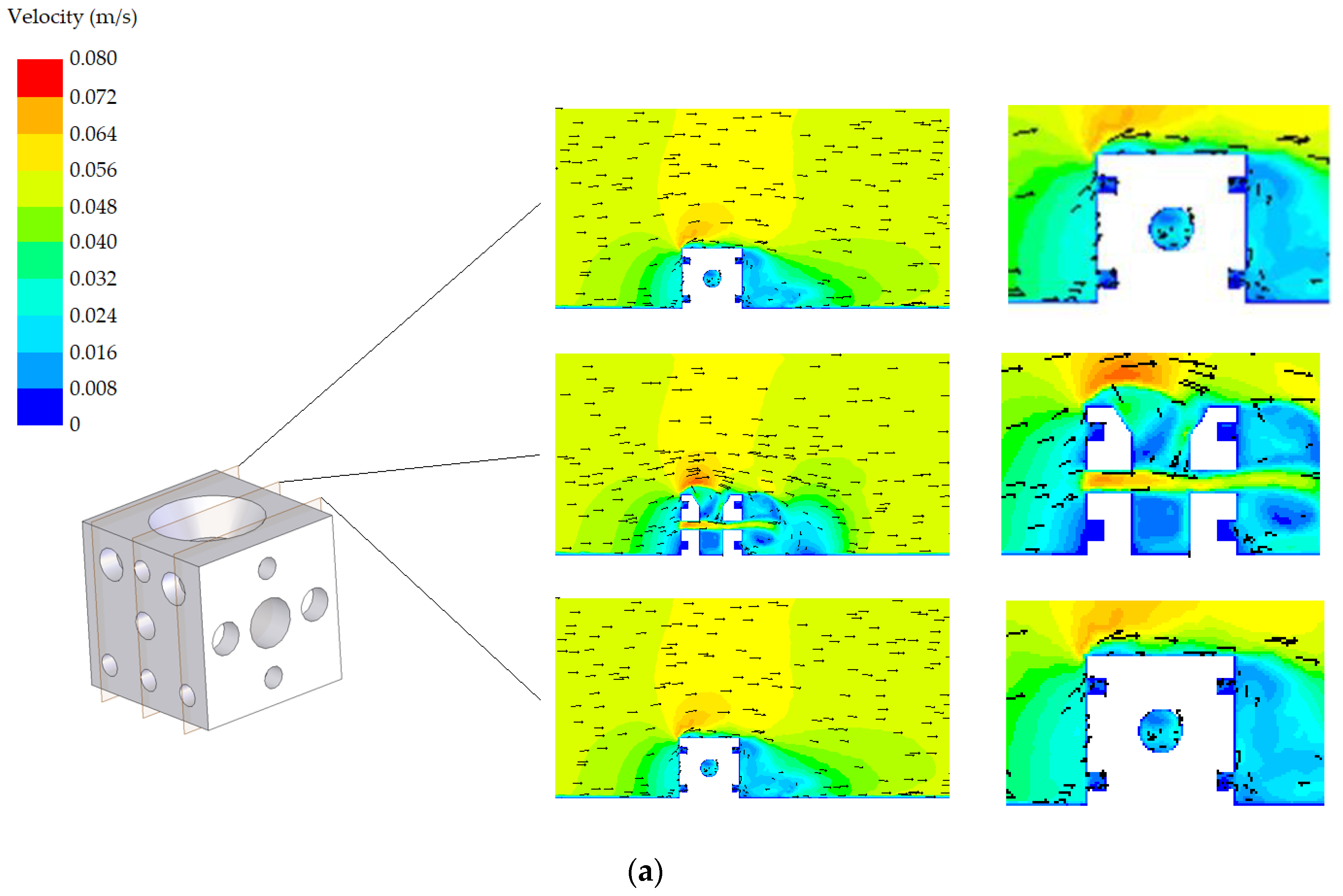
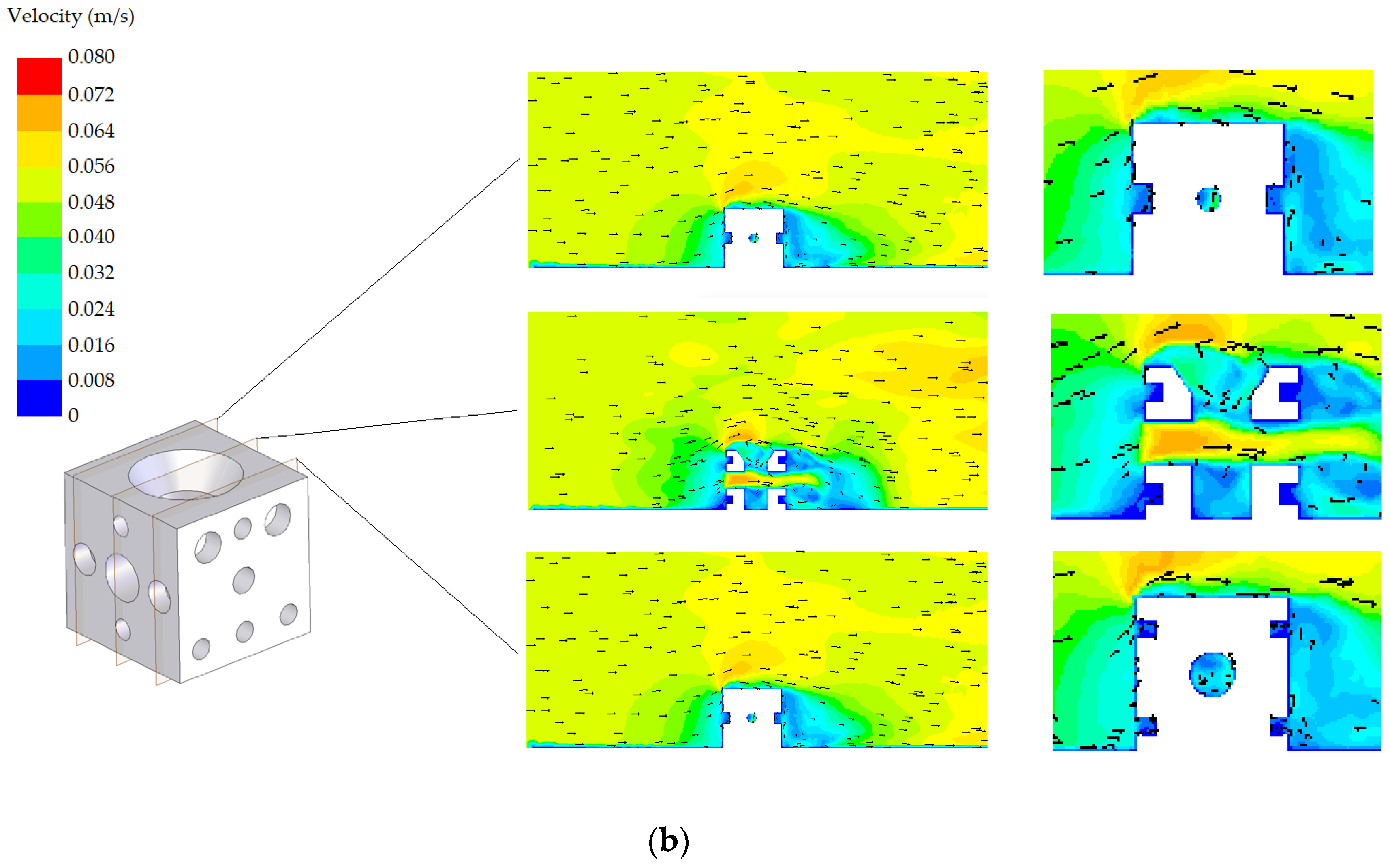
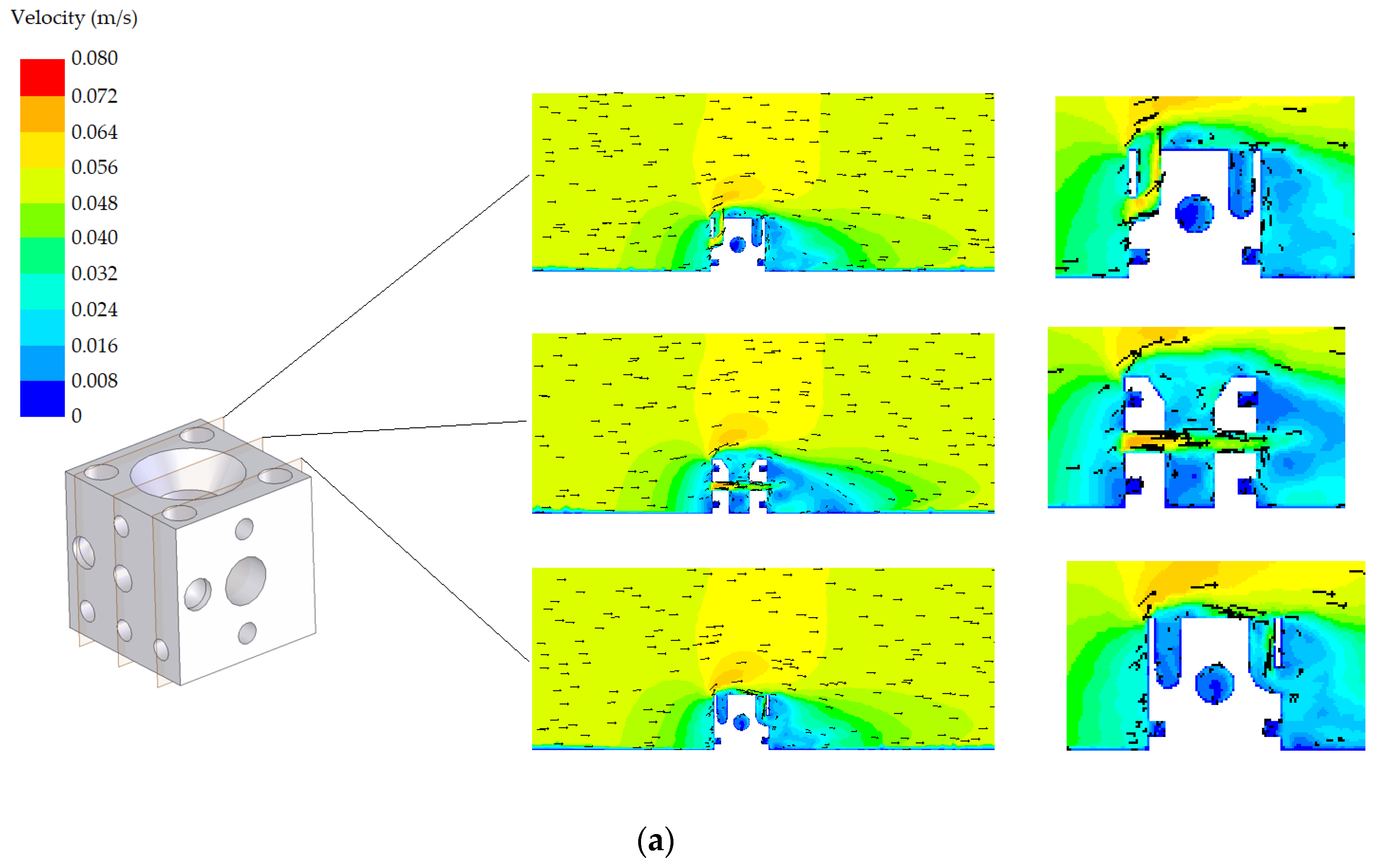
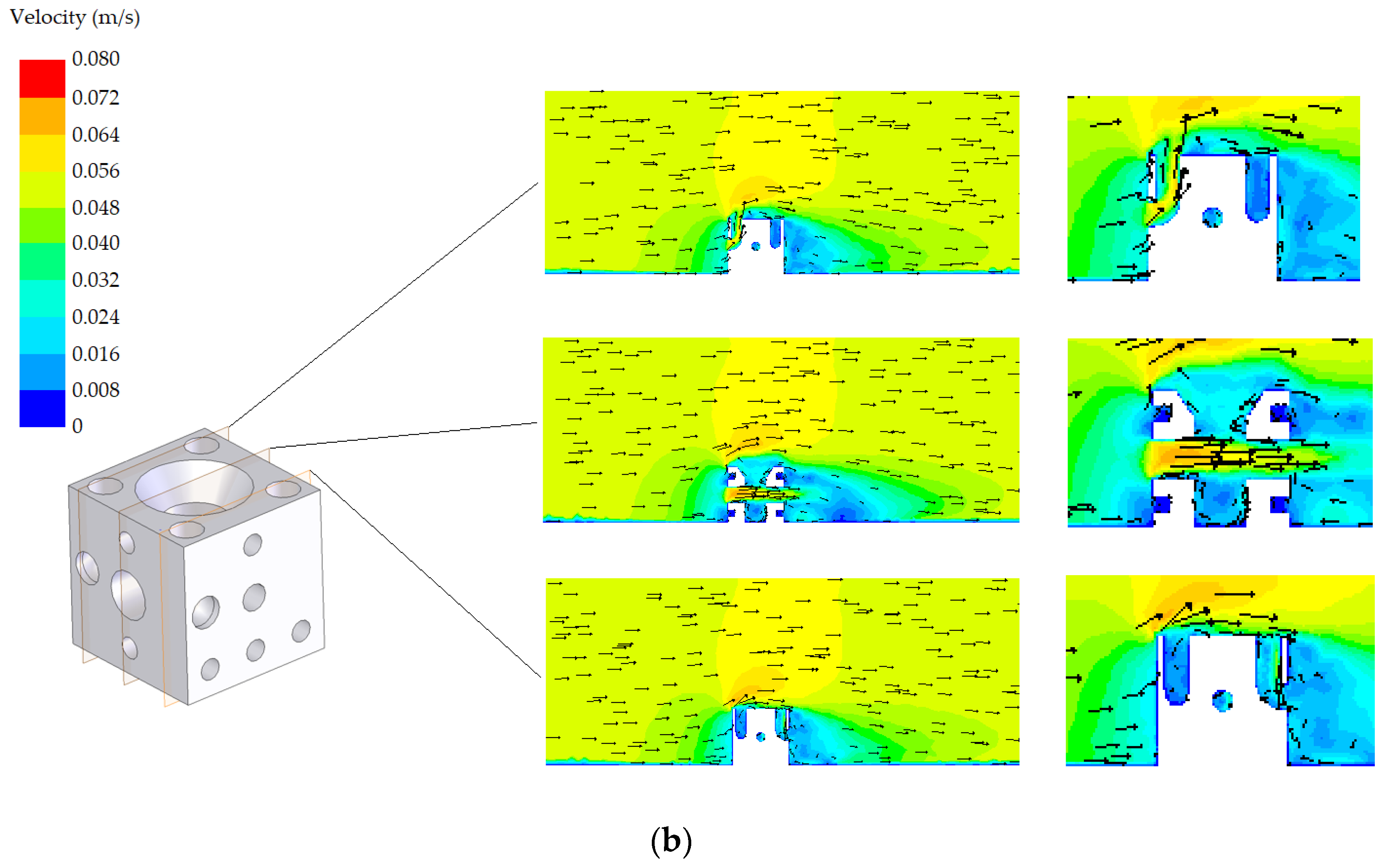
| Characteristic | Species | ||
|---|---|---|---|
| Octopus vulgaris | Sepia officinalis | Loligo vulgaris | |
| Cubic geometry | Optimal | Optimal | Sufficient |
| Cylindrical geometry | Sufficient | Sufficient | Optimal |
| Cavity with one opening | Optimal | Optimal | Sufficient |
| Cavity with two openings | Sufficient | Sufficient | Optimal |
| Design | Mesh | Orientation | Vupwelling (m3) | Vbackeddy (m3) | va (m/s) |
|---|---|---|---|---|---|
| Standard | Mesh 1 standard (symmetry) | Orientation A | 0.181 | 0.593 | 0.013 |
| Orientation B | 0.146 | 0.472 | 0.023 | ||
| Mesh 2 standard (symmetry) | Orientation A | 0.188 | 0.617 | 0.014 | |
| Orientation B | 0.152 | 0.491 | 0.024 | ||
| Mesh 3 standard (symmetry) | Orientation A | 0.189 | 0.619 | 0.014 | |
| Orientation B | 0.152 | 0.492 | 0.024 | ||
| Modified | Mesh 1 modified (no symmetry) | Orientation A | 0.196 | 0.625 | 0.021 |
| Orientation B | 0.158 | 0.523 | 0.029 | ||
| Mesh 2 modified (no symmetry) | Orientation A | 0.204 | 0.650 | 0.022 | |
| Orientation B | 0.164 | 0.544 | 0.030 | ||
| Mesh 3 modified (no symmetry) | Orientation A | 0.206 | 0.652 | 0.022 | |
| Orientation B | 0.165 | 0.546 | 0.031 |
| Relevant Information and Main Parameters | Standard Model | Modified Model |
|---|---|---|
| Geometrical characteristics | 12 nest cavities (20 cm diameter) 8 nest cavities (30 cm diameter) | 4 nest cavities (30 cm diameter) 12 nest cavities (20 cm diameter) |
| EM | 1 | 1 |
| NM | 1 | 1 |
| HM | 1 | 0.7 a |
| AREIT | 3 | 2.7 |
| Results | AR Design | |||
|---|---|---|---|---|
| Standard | Modified | |||
| Orientation A | Orientation B | Orientation A | Orientation B | |
| Ueffect | 2 | 1 | 2 | 1 |
| Beffect | 3 | 2 | 3 | 3 |
| Ieffect | 2 | 2 | 2 | 3 |
| NCM | 7 | 5 | 7 | 7 |
| NNC | 3 | 3 | 3 | 3 |
| SNC | 3 | 3 | 3 | 3 |
| TNC | 1 | 1 | 2 | 2 |
| HCM | 7 | 7 | 8 | 8 |
| NCC | 14 | 12 | 15 | 15 |
Disclaimer/Publisher’s Note: The statements, opinions and data contained in all publications are solely those of the individual author(s) and contributor(s) and not of MDPI and/or the editor(s). MDPI and/or the editor(s) disclaim responsibility for any injury to people or property resulting from any ideas, methods, instructions or products referred to in the content. |
© 2023 by the authors. Licensee MDPI, Basel, Switzerland. This article is an open access article distributed under the terms and conditions of the Creative Commons Attribution (CC BY) license (https://creativecommons.org/licenses/by/4.0/).
Share and Cite
Barros, J.J.C.; Galdo, M.I.L.; Guerreiro, M.J.R.; Couce, L.C. Biological and Hydrodynamic Aspects for the Design of Artificial Reef Modules for Cephalopod Molluscs in the Ares-Betanzos Estuary. J. Mar. Sci. Eng. 2023, 11, 1365. https://doi.org/10.3390/jmse11071365
Barros JJC, Galdo MIL, Guerreiro MJR, Couce LC. Biological and Hydrodynamic Aspects for the Design of Artificial Reef Modules for Cephalopod Molluscs in the Ares-Betanzos Estuary. Journal of Marine Science and Engineering. 2023; 11(7):1365. https://doi.org/10.3390/jmse11071365
Chicago/Turabian StyleBarros, Juan José Cartelle, María Isabel Lamas Galdo, María Jesús Rodríguez Guerreiro, and Luis Carral Couce. 2023. "Biological and Hydrodynamic Aspects for the Design of Artificial Reef Modules for Cephalopod Molluscs in the Ares-Betanzos Estuary" Journal of Marine Science and Engineering 11, no. 7: 1365. https://doi.org/10.3390/jmse11071365
APA StyleBarros, J. J. C., Galdo, M. I. L., Guerreiro, M. J. R., & Couce, L. C. (2023). Biological and Hydrodynamic Aspects for the Design of Artificial Reef Modules for Cephalopod Molluscs in the Ares-Betanzos Estuary. Journal of Marine Science and Engineering, 11(7), 1365. https://doi.org/10.3390/jmse11071365









